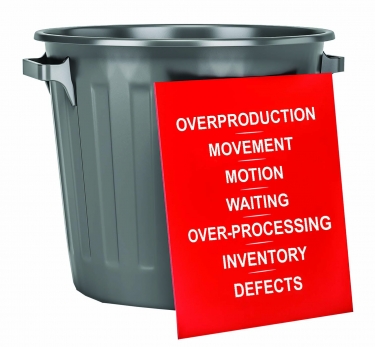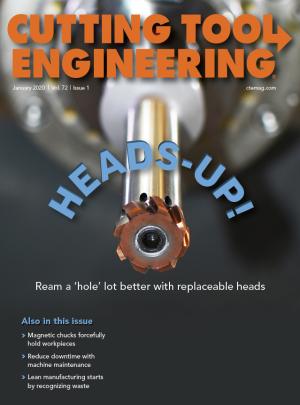
By now, almost everyone in manufacturing is probably familiar with the concepts of lean manufacturing or at least the term. Lean manufacturing can be so effective that many companies employ lean leaders, process improvement teams, kaizen teams or similar groups to help facilitate lean initiatives. Part manufacturers that do not have dedicated personnel or teams frequently hire consultants to aid with developing and implementing lean concepts.
Lean manufacturing has become an accepted practice at large and midsize companies, but small manufacturers, machine shops and fabrication shops have been slow to adopt the concepts. In my experience, owners and managers at smaller shops often believe that the concepts are applicable only to larger companies or that taking advantage of lean manufacturing concepts requires hiring people with special skills.
Focus on Waste
Those who are unknowledgeable about lean manufacturing easily can become intimidated by the concepts and tools, so implementation at places where these people work might be daunting. Very simply, lean manufacturing is the identification and elimination of waste in manufacturing processes and systems. Waste can be categorized in one of seven forms: movement, inventory, motion, waiting, overproduction, over-processing and defects.
The first step of the lean journey is learning to identify waste.
Movement. Traditional production at a machine shop moves batches of parts from workstation to workstation. A shaft, for example, may move from a lathe where turning is completed to a mill where keyways and cross-holes are drilled. A leaner method is using a work cell where all the necessary machines are close to each other so the shaft can go into the mill after turning, frequently using a robot. Another alternative could involve purchasing a lathe with milling capability to end the need for a separate mill.
Inventory. Most small shops fail because of inadequate cash flow. A shop must pay rent, buy materials and make payroll while waiting for funds to arrive from customer invoices, which can strain finances, and having cash tied up in inventory only exacerbates the problem. Identify and eliminate activities that create inventory. Resist the urge to make extra parts out of those last few inches of bar. Don’t buy a 208-liter (55-gallon) drum of coolant to save a few dollars per gallon when a 19-liter (5-gallon) pail will suffice. Try to remove the inventory of cutting tools by selecting ones that effectively machine a range of materials.
Motion. This form of waste is similar to movement but related to people, not parts, in a manufacturing system. Eliminating wasted motion often results in improved workstations. Consider the prior example involving a shaft. Eradicating unnecessary motion could be as simple as placing raw materials at an ergonomic height in a cell so machinists can retrieve them without bending, stooping or reaching. A shop could put machine tools in close proximity to each other or buy specially configured ones.
Waiting. This waste occurs when a machine or person cannot proceed because the previous step is incomplete. Waiting can be difficult to overcome in the low-volume, high-mix environment found at many small shops. Constructing a shaft cell to eliminate motion in the earlier example could cause waiting if turning operations take longer than milling operations.
Overproduction. A common statement at shops is “I made a few extra in case we scrap some.” Making more parts than required is typical at small shops and sounds good until actual costs are calculated. Overproduction also occurs when managers feel pressure to keep people and machines working despite no demand for parts or when there is a diminished backlog of work and a shop starts producing parts before they are needed.
Over-processing. Simply doing more than required is over-processing. One of the most common forms of over-processing at a machine shop is the quest for a superfine surface finish. Machinists are taught to strive for a good surface finish, so imparting one on a part is a way to demonstrate skill. Unfortunately, a customer who requires a 3.18 µm Ra (125 µin. Ra) finish usually won’t pay for the extra processing needed to produce a 1.62 µm Ra (64 µin. Ra) finish. Remember that providing high quality and craftsmanship means meeting a customer’s expectations, so a part that conforms to requests is good enough. Don’t go beyond what is obligated. This is a difficult concept to sell to skilled machinists.
Defects. It is easy to see why defects are wasteful. Anytime that parts have to be remade or reworked because of a defect, the costs are unrecoverable. Eliminating variation and developing robust processes are the best ways for small shops to avoid part defects. Establish effective methods for performing work, and encourage everyone at the shop to use them.
Lean concepts are not difficult to understand. They have a commonsense feel once they become routine. But creating a lean shop does not happen in a short period of time. Significant cultural change often is required, and people must alter habits and opinions that may have existed for years. Recognizing waste in manufacturing processes and systems is the first act to becoming lean — no matter the size of the company.
Related Glossary Terms
- coolant
coolant
Fluid that reduces temperature buildup at the tool/workpiece interface during machining. Normally takes the form of a liquid such as soluble or chemical mixtures (semisynthetic, synthetic) but can be pressurized air or other gas. Because of water’s ability to absorb great quantities of heat, it is widely used as a coolant and vehicle for various cutting compounds, with the water-to-compound ratio varying with the machining task. See cutting fluid; semisynthetic cutting fluid; soluble-oil cutting fluid; synthetic cutting fluid.
- gang cutting ( milling)
gang cutting ( milling)
Machining with several cutters mounted on a single arbor, generally for simultaneous cutting.
- lathe
lathe
Turning machine capable of sawing, milling, grinding, gear-cutting, drilling, reaming, boring, threading, facing, chamfering, grooving, knurling, spinning, parting, necking, taper-cutting, and cam- and eccentric-cutting, as well as step- and straight-turning. Comes in a variety of forms, ranging from manual to semiautomatic to fully automatic, with major types being engine lathes, turning and contouring lathes, turret lathes and numerical-control lathes. The engine lathe consists of a headstock and spindle, tailstock, bed, carriage (complete with apron) and cross slides. Features include gear- (speed) and feed-selector levers, toolpost, compound rest, lead screw and reversing lead screw, threading dial and rapid-traverse lever. Special lathe types include through-the-spindle, camshaft and crankshaft, brake drum and rotor, spinning and gun-barrel machines. Toolroom and bench lathes are used for precision work; the former for tool-and-die work and similar tasks, the latter for small workpieces (instruments, watches), normally without a power feed. Models are typically designated according to their “swing,” or the largest-diameter workpiece that can be rotated; bed length, or the distance between centers; and horsepower generated. See turning machine.
- lean manufacturing
lean manufacturing
Companywide culture of continuous improvement, waste reduction and minimal inventory as practiced by individuals in every aspect of the business.
- milling
milling
Machining operation in which metal or other material is removed by applying power to a rotating cutter. In vertical milling, the cutting tool is mounted vertically on the spindle. In horizontal milling, the cutting tool is mounted horizontally, either directly on the spindle or on an arbor. Horizontal milling is further broken down into conventional milling, where the cutter rotates opposite the direction of feed, or “up” into the workpiece; and climb milling, where the cutter rotates in the direction of feed, or “down” into the workpiece. Milling operations include plane or surface milling, endmilling, facemilling, angle milling, form milling and profiling.
- milling machine ( mill)
milling machine ( mill)
Runs endmills and arbor-mounted milling cutters. Features include a head with a spindle that drives the cutters; a column, knee and table that provide motion in the three Cartesian axes; and a base that supports the components and houses the cutting-fluid pump and reservoir. The work is mounted on the table and fed into the rotating cutter or endmill to accomplish the milling steps; vertical milling machines also feed endmills into the work by means of a spindle-mounted quill. Models range from small manual machines to big bed-type and duplex mills. All take one of three basic forms: vertical, horizontal or convertible horizontal/vertical. Vertical machines may be knee-type (the table is mounted on a knee that can be elevated) or bed-type (the table is securely supported and only moves horizontally). In general, horizontal machines are bigger and more powerful, while vertical machines are lighter but more versatile and easier to set up and operate.
- turning
turning
Workpiece is held in a chuck, mounted on a face plate or secured between centers and rotated while a cutting tool, normally a single-point tool, is fed into it along its periphery or across its end or face. Takes the form of straight turning (cutting along the periphery of the workpiece); taper turning (creating a taper); step turning (turning different-size diameters on the same work); chamfering (beveling an edge or shoulder); facing (cutting on an end); turning threads (usually external but can be internal); roughing (high-volume metal removal); and finishing (final light cuts). Performed on lathes, turning centers, chucking machines, automatic screw machines and similar machines.


